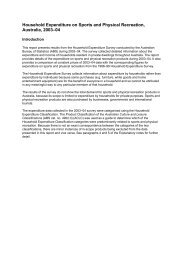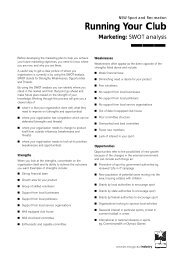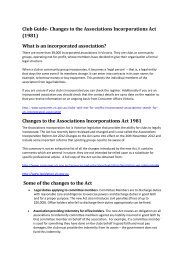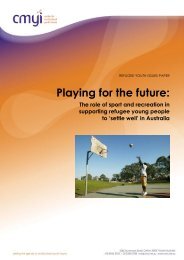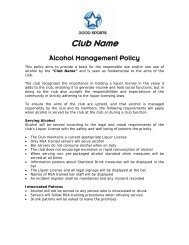School Playing Fields: Planning and Design Guidance - VicSport
School Playing Fields: Planning and Design Guidance - VicSport
School Playing Fields: Planning and Design Guidance - VicSport
You also want an ePaper? Increase the reach of your titles
YUMPU automatically turns print PDFs into web optimized ePapers that Google loves.
Primary schoolsThe calculations for primary school playing fieldrequirements can be simplified by consideringonly three basic sizes of school: those that haveone class in each year group – single-stream;those that have two classes per year group –two-stream; <strong>and</strong> those that have three classesper year group – three-stream.In many primary schools, outdoor PE canbe limited or even non-existent due to anunwillingness to take pupils onto grass playingfields which can be wet or muddy. Whilst this isby no means a universal problem, <strong>and</strong> sometimesdue to attitudes <strong>and</strong> practices rather than pitchquality, it is a significant constraint to participationin a large number of primary schools.sportscotl<strong>and</strong> considers that a synthetic grass‘sevens’ pitch is the optimum provision forprimary schools <strong>and</strong> would address this problemfor those schools whose grass playing fields arein poor condition or are perceived to beinappropriate. Synthetic grass will be particularlyuseful in delivering Active <strong>School</strong>s programmesat primary schools as they provide a reliable,useable space at a time when indoor PE spacesare often required by after school care clubs.Whilst a synthetic grass sevens pitch isrecommended, if none is provided then a grasssevens pitch will be required for each stream at aschool, as illustrated by the following calculations.Figure 6: Summary of basic assumptions forprimary schools.FactorsClass sizePE target<strong>Playing</strong> field useWorked example inputsSt<strong>and</strong>ard school class120 minutes per week40% of all PEExtra-curricular use 80% of pupils,1 hour per weekof playing fields (based on Sport 21, target 1)Grass pitch capacityInformal pupil use8 hoursNot includedFigure 7: Worked example to calculate school playing field requirements for a single streamprimary school.1. Curricular activityNo. of hours of PE per week required by each class.No. of classes in a single stream school. 72 hoursNo. of hours required for PE by the school. 14 hours i.e. 2 hours x 7classes.Proportion of PE taking place outdoors. 40%No. of hours spent on outdoor PE in a 5.6 hours i.e. 40% of 14.single stream school.Time out of one hour PE lesson spent on a pitch. 45 minutes i.e. 75% of lesson time.Actual use of playing fields in PE lessons for a 4.2 hours i.e. 75% of 5.6 = 4.2.single stream school.2. Extra-curricular activityProportion of school children physically active for at 80% Target 1 of Sport 21.least one hour a day on five or more days of the week.Assumption of extra-curricular activity on playing fields 1hour per pupilper year group to contribute to this target.As all pupils in the same class group are assumed toexercise together, this means one hour per class group.Total number of school hours. 7 hours 1hour x seven class groups.Figure for 80% of the pupils (as per Sport 21 Target 1). 5.6 hours i.e. 80% of 7.SummaryCurricular requirement.Extra-curricular requirement.Total4.2 hours5.6 hours9.8 hoursUsing the same principles for two <strong>and</strong> three stream schools, the results are as follows:Factoring this up for two <strong>and</strong> three stream schools meansOne streamTwo streamThree stream9.8 hours19.6 hours29.4 hours<strong>School</strong> <strong>Playing</strong> <strong>Fields</strong> 24<strong>School</strong> <strong>Playing</strong> <strong>Fields</strong> 25



